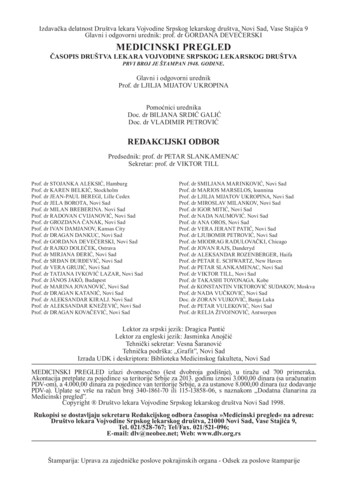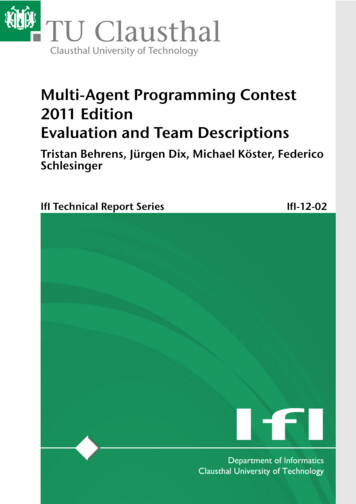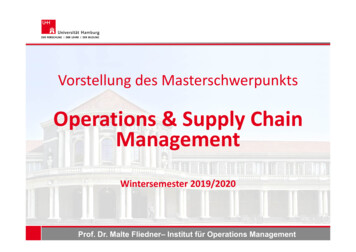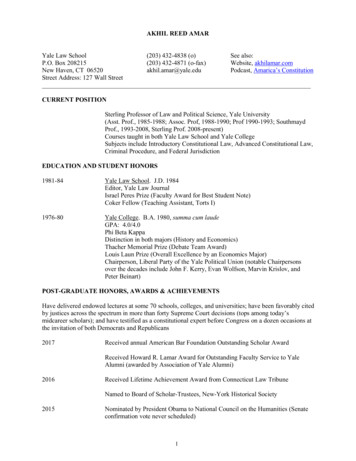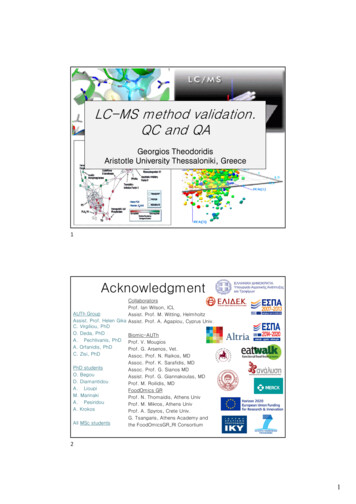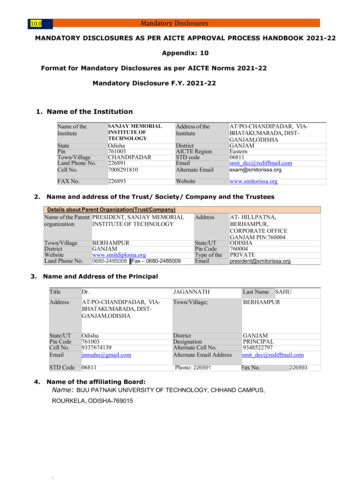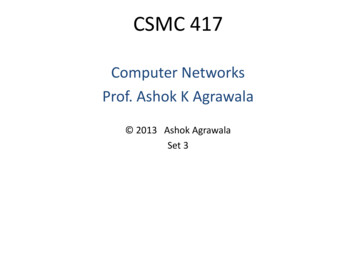
Transcription
CSMC 417Computer NetworksProf. Ashok K Agrawala 2013 Ashok AgrawalaSet 3
The Physical LayerFoundation on which otherlayers build– Properties of wires, fiber,wireless limit what thenetwork can doKey problem is to send (digital)bits using only ical
Digital Signals Take discrete values Function of time
Analog Signals Continuous function of time s(𝑡) A function of time can be represented as afunction of frequencies 𝑆 𝜔 where 𝜔 2𝜋𝑓
Time Domain and Frequency Domain 𝑠 𝑡 𝑆 𝜔 Here we consider 𝑠(𝑡)to be defined overthe whole range of time ( , ) And 𝑆 𝜔 is defined over the whole rangeof frequencies Fourier Transform
Fourier Analysis We model the behavior of variation of voltageor current with mathematical functions Fourier series is used Function reconstructed with
Fourier Analysis A time-varying signal can be equivalentlyrepresented as a series of frequency components(harmonics): Signal over timea, b weights of harmonics
Propagation of Signals Over a medium Signal is affected by the properties of the medium– Attenuation Signal intensity decreases with distance– Distortion Signal may not be affected uniformly at various frequencies– Noise Due to external sources Can be minimized but can not be totally eliminated Received signal is different from the sent signal
Properties of Medium Bandwidth– The range of frequencies that can pass through withminimal attenuation and distortion.– Voice over telephone uses a bandwidth of 4k Hz Propagation Speed– Speed of light– Distance between sender and receiver determine thepropagation delay
Bandwidth-Limited SignalsA binary signal and its root-mean-square Fourier amplitudes.(b) – (c) Successive approximations to the original signal.
Bandwidth-Limited Signals Having less bandwidth (harmonics) degrades thesignal8 harmonicsLost!Bandwidth4 harmonicsLost!2 harmonicsLost!
Guided Transmission (Wires & Fiber)Media have different properties, henceperformance– Reality check Storage media »– Wires: Twisted pairs » Coaxial cable » Power lines »– Fiber cables »
Reality Check: Storage mediaSend data on tape / disk / DVD for a highbandwidth link– Mail one box with 1000 800GB tapes (6400Tbit)– Takes one day to send (86,400 secs)– Data rate is 70 Gbps.Data rate is faster than long-distancenetworks!But, the message delay is very poor.
Link TerminologyFull-duplex link– Used for transmission in both directions at once– e.g., use different twisted pairs for each directionHalf-duplex link– Both directions, but not at the same time– e.g., senders take turns on a wireless channelSimplex link– Only one fixed direction at all times; not common
Twisted Pair(a) Category 3 UTP.(b) Category 5 UTP.
Twisted PairsCategory 5 UTP cable with four twisted pairs
Coaxial CableA coaxial cable.
Power LinesA network that uses household electrical wiring.
Fiber Optics (1)Three examples of a light ray from inside asilica fiber impinging on the air/silica boundaryat different angles.
Fiber Cables (1)Common for high rates and long distances– Long distance ISP links, Fiber-to-the-Home– Light carried in very long, thin strand of glassLight source(LED, laser)Light trapped bytotal internal reflectionPhotodetector
Fiber Cables (2)Fiber has enormous bandwidth (THz) and tiny signalloss – hence high rates over long distances
Fiber Cables (3)Single-mode– Core so narrow (10um) lightcan’t even bounce around– Used with lasers for longdistances, e.g., 100kmMulti-mode– Other main type of fiber– Light can bounce (50um core)– Used with LEDs for cheaper,shorter distance linksFibers in a cable
Fiber Cables (4)Comparison of the properties of wires and fiber:PropertyWiresFiberDistanceShort (100s of m)Long (tens of km)BandwidthModerateVery HighCostInexpensiveLess cheapConvenienceEasy to useLess easySecurityEasy to tapHard to tap
Fiber Optic NetworksA fiber optic ring with active repeaters.
Wireless Transmission– Electromagnetic Spectrum »– Radio Transmission »– Microwave Transmission »– Light Transmission »– Wireless vs. Wires/Fiber »
Electromagnetic Spectrum (1)Different bands have different uses: Radio: wide-area broadcast; Infrared/Light: line-of-sight Microwave: LANs and 3G/4G;Networking focusMicrowave
Electromagnetic Spectrum (2)To manage interference, spectrum is carefullydivided, and its use regulated and licensed,300 MHz3 GHze.g., sold at auction.WiFi (ISM bands)3 GHzSource: NTIA Office of Spectrum Management, 2003Part of the US frequency allocations30 GHz
Electromagnetic Spectrum (3)Fortunately, there are also unlicensed (“ISM”)bands: Free for use at low power; devices manage interference Widely used for networking; WiFi, Bluetooth, Zigbee, etc.802.11b/g/n802.11a/g/n
The Electromagnetic Spectrum (2)Spread spectrum and ultra-wideband(UWB) communication
Radio Transmission(a) In the VLF, LF, and MF bands, radio waves follow thecurvature of the earth.(b) In the HF band, they bounce off the ionosphere.
Microwave Transmission Microwaves have large bandwidth and are widelyused indoors (WiFi) and outdoors (3G, satellites)– Signal is attenuated/reflected by everyday objects– Strength varies with mobility due multipath fading, etc.
Light TransmissionLine-of-sight light (no fiber) can be used for links– Light is highly directional, has much bandwidth– Use of LEDs/cameras and lasers/photodetectors
Wireless vs. Wires/FiberWireless: Easy and inexpensive to deploy Naturally supports mobility Naturally supports broadcast Transmissions interfere and must be managed Signal strengths hence data rates vary greatlyWires/Fiber: Easy to engineer a fixed data rate over point-to-pointlinks Can be expensive to deploy, esp. over distances Doesn’t readily support mobility or broadcast
Communication SatellitesSatellites are effective for broadcastdistribution and anywhere/anytimecommunications– Kinds of Satellites »– Geostationary (GEO) Satellites »– Low-Earth Orbit (LEO) Satellites »– Satellites vs. Fiber »
Kinds of SatellitesSatellites and their properties vary byaltitude:– Geostationary (GEO), Medium-Earth OrbitSats needed forglobal coverage(MEO), and Low-Earth Orbit (LEO)
Communication Satellites (2)The principal satellite bands.
Geostationary SatellitesGEO satellites orbit 35,000 km above a fixed location VSAT (computers) can communicate with the help of a hub Different bands (L, S, C, Ku, Ka) in the GHz are in use but may becrowded or susceptible to rain.GEO satelliteVSAT
Low-Earth Orbit SatellitesIridium(a) The Iridium satellites from six necklaces around theearth.(b) 1628 moving cells cover the earth.
Globalstar(a) Relaying in space.(b) Relaying on the ground.
Satellite vs. FiberSatellite: Can rapidly set up anywhere/anytimecommunications (after satellites have beenlaunched) Can broadcast to large regions Limited bandwidth and interference to manageFiber: Enormous bandwidth over long distances Installation can be more expensive/difficult
Digital Modulation and MultiplexingModulation schemes send bits as signals;multiplexing schemes share a channelamong users.– Baseband Transmission »– Passband Transmission »– Frequency Division Multiplexing »– Time Division Multiplexing »– Code Division Multiple Access »
Baseband Transmission Line codes send symbols that represent one or more bits– NRZ is the simplest, literal line code ( 1V “1”, -1V “0”)– Other codes tradeoff bandwidth and signal transitions Four different line codes
Clocks Sender sends a signal according to its clock Receiver should examine the received signal at themidpoint of a bit time.– Receiver has to get the timing information about thesender’s clock
Clock Recovery To decode the symbols, signals need sufficient transitions– Otherwise long runs of 0s (or 1s) are confusing, e.g.:01000000000 um, 0? er, 0? Strategies:– Manchester coding, mixes clock signal in every symbol– 4B/5B maps 4 data bits to 5 coded bits with 1s and 01111– Scrambler XORs tx/rx data with pseudorandom bitsCode11010110111110011101
Clock Recovery4B/5B mapping.
Modulation 𝑠 𝑡 𝑎 𝑆𝑖𝑛 2𝜋𝑓𝑡 𝜃– Where 𝑎 is the amplitude 𝑓 is the frequency 𝜃 is the phase Use any of these for representing digital signal– Amplitude Modulation– Frequency Modulation– Phase Modulation
Passband Transmission (1)Modulating the amplitude, frequency/phase of acarrier signal sends bits in a (non-zero) frequencyrangeNRZ signal of bitsAmplitude shift keyingFrequency shift keyingPhase shift keying
Passband Transmission (2)(a) QPSK. (b) QAM-16. (c) QAM-64.
Passband Transmission (3)Gray-coding assigns bits to symbols so that smallsymbol errors cause few bit errors:BECAD
Modems (3)(a)(a) V.32 for 9600 bps.(b) V32 bis for 14,400 bps.(b)
Frequency Division Multiplexing (2)Frequency division multiplexing. (a) The original bandwidths.(b) The bandwidths raised in frequency.(c) The multiplexed channel.
Frequency Division Multiplexing (3)Orthogonal frequency divisionmultiplexing (OFDM).
Time Division Multiplexing (TDM)Time division multiplexing shares a channel overtime:– Users take turns on a fixed schedule; this is not packetswitching or STDM (Statistical TDM)– Widely used in telephone / cellular systems
Code Division Multiple Access (CDMA)CDMA shares the channel by giving users a code– Codes are orthogonal; can be sent at the same time– Widely used as part of 3G networksSender CodesA TransmittedSignal 1 1-1-1 2B 1 1-1 -100Receiver DecodingS x A 2 20000SxB-2 -2Sum 4A sent “1”Sum -4B sent “0”-2C 1 1-1 -1S A -BS x C 200-2Sum 0C didn’t send
Code Division Multiplexing (1)(a) Chip sequences for four stations.(b) Signals the sequences represent
Code Division Multiplexing (2)(a) Six examples of transmissions.(b) Recovery of station C’s
Public Switched Telephone System Structure of the Telephone SystemThe Politics of TelephonesThe Local Loop: Modems, ADSL and WirelessTrunks and MultiplexingSwitching
Structure of the Telephone System(a) Fully-interconnected network.(b) Centralized switch.(c) Two-level hierarchy.
Structure of the Telephone SystemA hierarchical system for carrying voice calls madeof:– Local loops, mostly analog twisted pairs to houses– Trunks, digital fiber optic links that carry calls– Switching offices, that move calls among trunks
The Politics of Telephones In the U.S., there is a distinction for competition betweenserving a local area (LECs) and connecting to a local area (at aPOP) to switch calls across areas (IXCs)– Customers of a LEC can dial via any IXC they choose
The Politics of TelephonesThe relationship of LATAs, LECs, and IXCs. All the circlesare LEC switching offices. Each hexagon belongs to theIXC whose number is on it.
Major Components of the TelephoneSystem Local loops Analog twisted pairs going to houses andbusinesses Trunks Digital fiber optics connecting the switching offices Switching offices Where calls are moved from one trunk to another
Local loop (2): Digital Subscriber LinesDSL broadband sends data over the local loop to the localoffice using frequencies that are not used for POTS–Telephone/computers attach to the sameold phone line–Rates vary with line ADSL2 up to 12 Mbps–OFDM is used up to1.1 MHz for ADSL2 Most bandwidthdown
Local loop (3): Fiber To The HomeFTTH broadband relies on deployment of fiber opticcables to provide high data rates customers– One wavelength can be shared among many houses– Fiber is passive (no amplifiers, etc.)
The Local Loop: Modems, ADSL,and WirelessThe use of both analog and digital transmissions for a computerto computer call. Conversion is done by the modems andcodecs.
Digital Subscriber LinesBandwidth versus distanced over category 3 UTP forDSL.
Digital Subscriber Lines (2)Operation of ADSL using discrete multitonemodulation.
Digital Subscriber Lines (3)A typical ADSL equipment configuration.
Wireless Local LoopsArchitecture of an LMDS system.
Fiber To The HomePassive optical network for Fiber To The Home.
Trunks and Multiplexing (1)Calls are carried digitally on PSTN trunks using TDM– A call is an 8-bit PCM sample each 125 μs (64 kbps)– Traditional T1 carrier has 24 call channels each 125 μs(1.544 Mbps) with symbols based on AMI
Time Division Multiplexing (2)Delta modulation.
Time Division Multiplexing (3)Multiplexing T1 streams into higher carriers.
Time Division Multiplexing (4)Two back-to-back SONET frames.
Time Division Multiplexing (5)SONET and SDH multiplex rates.
Wavelength Division MultiplexingWavelength division multiplexing.
Switching (1) PSTN uses circuit switching; Internet uses packetswitchingPSTN:Internet:
Switching (2)Circuit switchingrequires call setup(connection) beforedata flows smoothly– Also teardown at end(not shown)Packet switching treatsmessagesindependently– No setup, but variablequeuing delay at routersCircuitsPackets
Message Switching(a) Circuit switching (b) Message switching (c) Packet switching
Packet SwitchingA comparison of circuit switched and packet-switched networks.
Mobile Telephone System– Generations of mobile telephone systems »– Cellular mobile telephone systems »– GSM, a 2G system »– UMTS, a 3G system »
Generations of mobile telephonesystems1G, analog voice AMPS (Advanced Mobile Phone System) is example, deployedfrom 1980s. Modulation based on FM (as in radio).2G, analog voice and digital data GSM (Global System for Mobile communications) is example,deployed from 1990s. Modulation based on QPSK.3G, digital voice and data UMTS (Universal Mobile Telecommunications System) isexample, deployed from 2000s. Modulation based on CDMA4G, digital data including voice LTE (Long Term Evolution) is example, deployed from 2010s.Modulation based on OFDM
Cellular mobile phone systemsAll based on notion of spatial regions called cells Each mobile uses a frequency in a cell; moves cause handoff Frequencies are reused across non-adjacent cells To support more mobiles, smaller cells can be usedCellular reuse patternSmaller cells for dense mobiles
Channel CategoriesThe 832 channels are divided into four categories: Control (base to mobile) to manage the system Paging (base to mobile) to alert users to calls forthem Access (bidirectional) for call setup and channelassignment Data (bidirectional) for voice, fax, or data
D-AMPSDigital Advanced Mobile Phone System(a) A D-AMPS channel with three users.(b) A D-AMPS channel with six users.
GSM – Global System for MobileCommunications (1)– Mobile is divided into handset and SIM card (Subscriber Identity Module)with credentials– Mobiles tell their HLR (Home Location Register) their currentwhereabouts for incoming calls– Cells keep track of visiting mobiles (in the Visitor LR)
GSM – Global System for MobileCommunications (2)Air interface is based on FDM channels of 200 KHz divided inan eight-slot TDM frame every 4.615 ms– Mobile is assigned up- and down-stream slots to use– Each slot is 148 bits long, gives rate of 27.4 kbps
GSM (2)A portion of the GSM framing structure.
UMTS – Universal MobileTelecommunications System (1)Architecture is an evolution of GSM; terminology differsPackets goes to/from the Internet via SGSN/GGSNInternet
CDMA – Code Division Multiple Access(a) Binary chip sequences for four stations(b) Bipolar chip sequences(c) Six examples of transmissions(d) Recovery of station C’s signal
Third-Generation Mobile Phones:Digital Voice and DataBasic services an IMT-2000 network should provide High-quality voice transmissionMessaging (replace e-mail, fax, SMS, chat, etc.)Multimedia (music, videos, films, TV, etc.)Internet access (web surfing, w/multimedia.)
Digital Voice and Data (2)Soft handoff (a) before, (b) during, and (c) after.
Cable Television– Internet over cable »– Spectrum allocation »– Cable modems »– ADSL vs. cable »
Community Antenna TelevisionAn early cable television system.
Internet over CableInternet over cable reuses the cable television plant– Data is sent on the shared cable tree from the headend, not on a dedicated line per subscriber (DSL)ISP(Internet)
Spectrum AllocationUpstream and downstream data are allocatedto frequency channels not used for TVchannels:
Cable ModemsCable modems at customer premises implement thephysical layer of the DOCSIS standard– QPSK/QAM is used in timeslots on frequencies that areassigned for upstream/downstream data
Cable vs. ADSLCable: Uses coaxial cable to customers (good bandwidth) Data is broadcast to all customers (less secure) Bandwidth is shared over customers so may varyADSL: Bandwidth is dedicated for each customer Point-to-point link does not broadcast data Uses twisted pair to customers (lower bandwidth)
Iridium (a) The Iridium satellites from six necklaces around the earth. (b) 1628 moving cells cover the earth. Globalstar (a) Relaying in space. (b) Relaying on the ground. Satellite vs. Fiber Satellite: Can rapidly set up anywhere/anytime communications (after satellites have been

